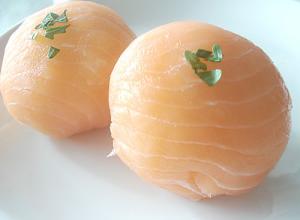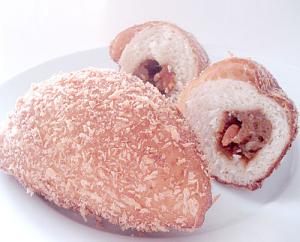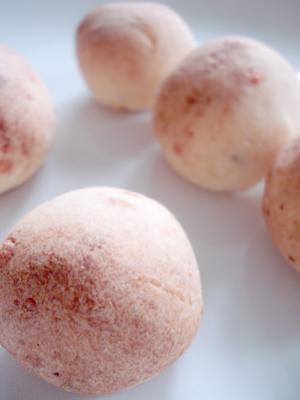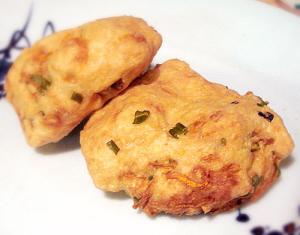
Following up on the previous recipe for shell shaped sushi, here is another kind of sushi that's great for parties. Temari are small cloth balls made from leftover scraps of kimono fabric, and temari zushi are meant to look like these colorful toys.
You can make temari zushi with any number of things, such as thinly sliced sashimi grade fish, boiled and butterflied shrimp, thinly sliced and cooked or uncooked vegetables, and even thin slices of cheese. You will likely never see temari zushi at a sushi restaurant - this is homey home-style sushi.
For these, I've used thinly cut slices of pale pink smoked salmon, with tiny amount of cream cheese inside, rather in the same vein as a New York Roll - quite non-traditional but it's a great combination. The key is to make the temari zushi on the small side since they are quite rich.
Filed under:
japanese party food spring rice sushi fish bento

There's a whole category of breads in Japan called okazu pan. Okazu are the savory dishes that you eat with your bowl of rice at a typical meal, and okazu pan are little breads with savory fillings.
Since curry flavored anything is a hit in Japan, curry bread or kare- pan is one of the most popular okazu pan varieties. It's a bun made of slightly sweet dough, filled with a spoonful of curry, breaded and deep fried. I am not sure how curry bread originated, but I am guessing it was inspired by Russian piroshki (piroshiki is also a popular okazu pan, though in the Japanese version it often contains very non-Russian fillings like harusame, thin bean noodles). Curry bread is sold at bakeries and convenience stores throughout Japan.
Making curry bread is a bit tricky since it's deep-fried. It's easy to make an oily, soggy lump if you fry it too long or at too low a temperature, but if you don't fry it long enough the center part where the dough meets the filling may be raw. My solution for this is to fry it until it's puffed and crisped, then to finish it in the oven. The other trick is to roll out the dough as thinly as you can manage without making it so thin that the curry is going to burst through.
You also have to be careful about the consistency of the curry filling. It's most convenient to start out with some leftover curry, but it has to be reduced down to a very thick, paste-like consistency, otherwise it will run over the dough and make the dough hard to seal. If the dough is not sealed properly, the bun will burst in the oil, which ends up to be quite a mess (oil seeps in, filling seeps out).
All in all, I am not sure I would bother to make curry bread at all if I lived near a Japanese bakery, but I do on occasion get a craving for this very down to earth snack. Try it if you're up for a bit of a challenge. This recipe is adapted from one in an out-of-print Japanese bread book.
Filed under:
bread japanese snack baking curry

I don't know how this escaped me until now, but there are actually two cookbooks available in English by one of the best teachers of traditional washoku or Japanese cooking, Tokiko Suzuki. Japanese Homestyle Cooking, published in 2000, is the more recent one, and The Essentials of Japanese Cooking is the other, published in 1995.
Filed under:
books and media japanese
Japanese people have a long standing tradition of adapting words from other languages when a Japanese word or term doesn't exist for something. The language most often borrowed from is English, but other languages are freely raided too. Often, the original meaning of the word changes quite a bit (see this post on my personal blog about the use of one such word, "mansion") which can be confusing for the non-Japanese speaker.
Filed under:
japanese offbeat
Since there seems to be interest in Japanese cookbook reviews, I will be posting some here periodically!
The question is, where is the best place to shop for Japanese books, magazines, DVDs and such? If you have a Japanese bookstore near you, that's the best place. One tip for buying magazines: the most recent issue of any magazine has been airmailed to the store, so the price you'll be charged is for the cost of the magazine plus that airmail cost. However, if there are any issues left after a month, the stores may sell them for a discount. (Kinokuniya in New York and San Francisco both do this.) Since most food magazines are not that timely, this works out well.
If you don't have a Japanese bookstore near you, the two biggest and most user-friendly online bookstores for Japanese language material are Yes Asia and Amazon Japan. I've bought stuff from both, and in terms of customer service and so on both are pretty good.
Filed under:
books and media japanese shopping

This may not be well known outside of the two respective countries, but there are pretty strong historical and cultural ties between Japan and Brazil. There was a wave of emigration from Japan to Brazil in the early part of the 20th century and later on around the '50s and '60s. And in the last 30 years, many Brazilians of Japanese descent (people of Japanese descent born in another country are called nikkei-jin) have in turn emigrated to Japan to fill labor shortages. Perhaps because of this, a few years ago one of the staples of the Brazilian diet, pao de queijo, little cheese breads, became very popular. While their popularity may have descended a bit from their peaks (Japan tends to be periodically swept up by big food or fashion trends, which after a time get dropped without warning when people move onto the next thing, but that's another story), they are still made by bakers throughout Japan.
I think that pao de queijo appeals so much to the Japanese palate because they are small, round and cute, and have a distinctive gooey-sticky-glutinous kind of texture inside. This texture is called mochi mochi, after mochi, the very gooey-glutinous rice cakes.
Filed under:
bread cheese japanese potatoes vegetarian quickbread brazilian fusion gluten-free
Recently reader Joanna emailed asking why her home made tofu was, while creamy, not turning into an actual block of tofu. This happens to me sometimes too. The non-coagulated creamy tofu (which looks rather like fresh ricotta) can still be used in ganmodoki and other recipes that call for mashed up tofu, so it doesn't have to go to waste. Still, it is disappointing when, after all the trouble you've gone to to make tofu, your carefully formed block disintegrates instead of holding firm.
Filed under:
japanese tofu

Ganmodoki or hiryouzu are small deep-fried fritters made of tofu and various ingredients. They are either eaten as-is or cooked in a broth. They are used as a meat substitute in sho-jin ryouri, vegan buddhist cuisine. (They are supposed to taste like deer meat, though they don't at all.)
Ganmodoki is sold pre-made in supermarkets, in the refrigerated section, and is usually eaten in an oden, a sort of stew of various fishcakes and such. But store bought ganmodoki, which has the texture of a sponge, is nothing like freshly made ganmodoki. Once you have tried a freshly made, piping hot ganmodoki, it's just about impossible to think about saving them for later.
I have tried baking these or pan-frying them instead of deep frying, but the texture just isn't the same. It just demands that crispy-crunchy delicate crust given by the oil. If it's any consolation, they don't really absorb much oil.
Yamaimo
One ingredient that gets omitted in a lot of English-language ganmodoki recipes is yamaimo, often called Japanese Yam. It is a root vegetable that is tremendously viscous in texture, sort of like the inside of an okra. It gives a sort of bouncy yet light texture to whatever it's added to. You can find fresh yamaimo in the produce section of Japanese grocery stores, cut into sections and wrapped in plastic. It's quite expensive but you usually only need a little bit of it, and keeps quite well in the refrigerator well as long as you re-wrap it in plastic to prevent the ends from oxidizing. The cut ends were traditionally dipped in some fine sawdust for storage. You may also be able to find yamaimo powder (Note to European readers - Japan Centre in the UK carries this). Regular grated potato can be used as a substitute if you can't find yamaimo - it gives a different texture but still adds that sort of bouncy quality. It has to be grated to a fine pulp, not into shreds.
The other ingredients
All the additions to ganmodoki are there to add texture, umami, or both. You can vary it quite a bit by adding things that capture your imagination. You can even turn it into a more Western-flavored item by adding things like green peas, finely chopped and cooked mushrooms, and so on, and eating them with a bit of Worcestershire sauce or even ketchup. However, to my mind the traditional Japanese flavor is the best.
Filed under:
japanese vegetarian tofu vegan
A lot of Japanese dishes are quite subtly flavored to start with, and are eaten dipped in a simple soy sauce based dipping sauce. You're probably familiar already with the wasabi + soy sauce combination used for most kinds of sashimi and sushi, but there are a few others. Which sauce goes with which dish really seems to depend as much on tradition as anything, though certain combinations just fit better than others. The ratio of flavoring to soy sauce is a matter of personal taste in most cases.
Whenever using a dipping sauce, try not to dunk whatever you are eating into it. The common sushi eating mistake made is to dunk the rice side into soy sauce - this not only makes the rice grains go all over the place, often down your front, but absorbs way too much soy sauce. Turn the sushi over and dip the fish just a bit instead. (I tend to think that this rice-dunking is why a lot of the finer sushi restaurants nowadays serve their sushi pre-seasoned, needing no dipping.)
Here are the most commonly used dipping sauce combinations:
Filed under:
basics japanese ingredients
Happy Valentine's Day! February the 14th may mean flowers, a romantic dinner, or promises you don't intend to keep for other people, but to me it will always the Day Of Chocolate.
Valentine's Day is a very odd and overly commercialized day in Japan, where the giving and receiving of chocolate doesn't have that much to do with romance. Females are made to feel obligated to hand out chocolates to people they don't care about, such as teachers and bosses, while males anxiously wait to see if they get 'enough' chocolates to satisfy their egos. There are whole lines of inexpensive chocolate products suitable for giving, called giri choco (obligation chocolate). Unlike in the Western world, it's not a day for men to give something to their female love interests. (March 14th, called "White Day", has been sort of artificially designated as the males-give-back-to-females day.)
Filed under:
chocolate japanese memories valentine
Pages